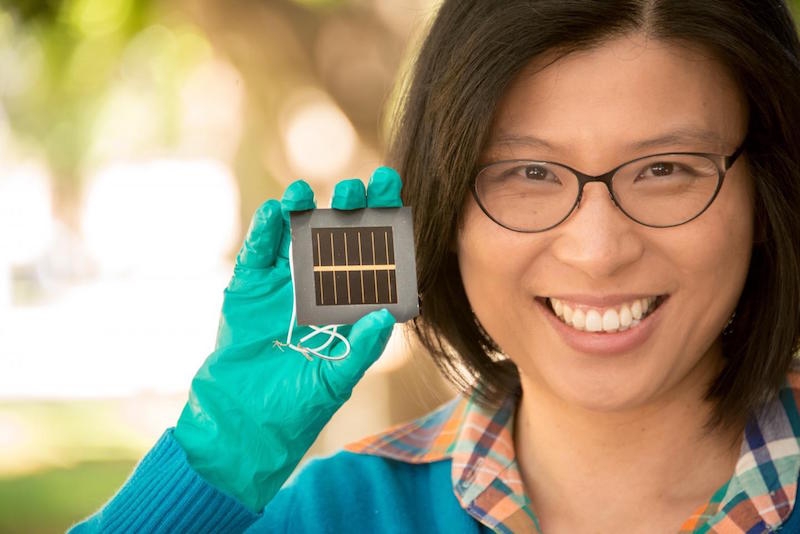
Features
Energy & Power
Renewables
Ho-Baillie and team claim latest best efficiency rating for perovskite PV cell
December 1, 2016 | By Anthony Capkun
 Dr. Anita Ho-Baillie with the new perovskite cell. Photo Rob Largent/UNSW.
Dr. Anita Ho-Baillie with the new perovskite cell. Photo Rob Largent/UNSW. December 1, 2016 – Anita Ho-Baillie, a senior research fellow at the Australian Centre for Advanced Photovoltaics (ACAP), says her team at the University of New South Wales in Sydney has achieved the highest efficiency rating with the largest perovskite solar cells to date.
“This is a very hot area of research, with many teams competing to advance photovoltaic design,” said Ho-Baillie. “Perovskites came out of nowhere in 2009, with an efficiency rating of 3.8%, and have since grown in leaps and bounds. And I think we can get to 24% within a year or so.”
The 12.1% efficiency rating achievement was for a 16 cm2 perovskite solar cell, the largest single perovskite PV cell certified with the highest energy conversion efficiency, says UNSW. The achievement was independently confirmed by Newport Corp. (Bozeman, Mont.). The new cell is at least 10X bigger than the current certified high-efficiency perovskite solar cells on record, adds UNSW.
Ho-Baillie’s team has also achieved an 18% efficiency rating on a 1.2 cm2 single perovskite cell, and 11.5% for a 16 cm2 four-cell perovskite mini-module—both independently certified by Newport.
Perovskite is a structured compound, where a hybrid organic-inorganic lead or tin halide-based material acts as the light-harvesting active layer. They are the fastest-advancing solar technology to date, and are attractive because the compound is cheap to produce and simple to manufacture, and can even be sprayed onto surfaces, explains UNSW.
“The versatility of solution deposition of perovskite makes it possible to spray-coat, print or paint on solar cells,” said Ho-Baillie. “The diversity of chemical compositions also allows cells to be transparent, or made of different colours. Imagine being able to cover every surface of buildings, devices and cars with solar cells.”
Some background on perovskite cells
UNSW explains most of the world’s commercial solar cells are made from a refined, highly purified silicon crystal and need to be baked above 800C in multiple high-temperature steps. Perovskites, on the other hand, are made at low temperatures and are 200X thinner than silicon cells.
But while perovskites hold much promise for cost-effective solar energy, they are currently prone to fluctuating temperatures and moisture, making them last only a few months without protection. Along with every other team in the world, Ho-Baillie’s is trying to extend their durability.
To make a perovskite solar cells, engineers grow crystals in a structure named after Lev Perovski (the mineralogist who discovered it). They first dissolve a selection of compounds in a liquid to make the ‘ink’, which is then deposited on a specialized glass that conducts electricity. When the ink dries, it leaves behind a thin film that crystallizes on top of the glass when mild heat is applied, resulting in a thin layer of perovskite crystals.
The tricky part is growing a thin film of crystals so the resulting solar cell absorbs a maximum amount of light. Worldwide, engineers are working to create smooth and regular layers of perovskite with large crystal grain sizes to increase PV yields.
PHOTO: Dr. Anita Ho-Baillie, a senior research fellow at the Australian Centre for Advanced Photovoltaics at UNSW, with the new perovskite cell. Photo Rob Largent/UNSW.
— With files from University of New South Wales.
Print this page